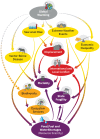Climate Endgame: Exploring catastrophic climate change scenarios
- PMID: 35914185
- PMCID: PMC9407216
- DOI: 10.1073/pnas.2108146119
Climate Endgame: Exploring catastrophic climate change scenarios
Abstract
Prudent risk management requires consideration of bad-to-worst-case scenarios. Yet, for climate change, such potential futures are poorly understood. Could anthropogenic climate change result in worldwide societal collapse or even eventual human extinction? At present, this is a dangerously underexplored topic. Yet there are ample reasons to suspect that climate change could result in a global catastrophe. Analyzing the mechanisms for these extreme consequences could help galvanize action, improve resilience, and inform policy, including emergency responses. We outline current knowledge about the likelihood of extreme climate change, discuss why understanding bad-to-worst cases is vital, articulate reasons for concern about catastrophic outcomes, define key terms, and put forward a research agenda. The proposed agenda covers four main questions: 1) What is the potential for climate change to drive mass extinction events? 2) What are the mechanisms that could result in human mass mortality and morbidity? 3) What are human societies' vulnerabilities to climate-triggered risk cascades, such as from conflict, political instability, and systemic financial risk? 4) How can these multiple strands of evidence-together with other global dangers-be usefully synthesized into an "integrated catastrophe assessment"? It is time for the scientific community to grapple with the challenge of better understanding catastrophic climate change.
Keywords: Anthropocene; Earth system trajectories; catastrophic climate change; climate change; tipping elements.
Conflict of interest statement
The authors declare no competing interest.
Figures



Comment in
-
Reply to Burgess et al: Catastrophic climate risks are neglected, plausible, and safe to study.Proc Natl Acad Sci U S A. 2022 Oct 18;119(42):e2214884119. doi: 10.1073/pnas.2214884119. Epub 2022 Oct 10. Proc Natl Acad Sci U S A. 2022. PMID: 36215481 Free PMC article. No abstract available.
-
Catastrophic climate risks should be neither understated nor overstated.Proc Natl Acad Sci U S A. 2022 Oct 18;119(42):e2214347119. doi: 10.1073/pnas.2214347119. Epub 2022 Oct 10. Proc Natl Acad Sci U S A. 2022. PMID: 36215483 Free PMC article. No abstract available.
-
Reply to Kelman: The foundations for studying catastrophic climate risks.Proc Natl Acad Sci U S A. 2022 Oct 18;119(42):e2214794119. doi: 10.1073/pnas.2214794119. Epub 2022 Oct 10. Proc Natl Acad Sci U S A. 2022. PMID: 36215499 Free PMC article. No abstract available.
-
From Climate Endgame to Climate Long Game.Proc Natl Acad Sci U S A. 2022 Nov 8;119(45):e2214975119. doi: 10.1073/pnas.2214975119. Epub 2022 Nov 2. Proc Natl Acad Sci U S A. 2022. PMID: 36322727 Free PMC article. No abstract available.
-
Reply to Bhowmik et al.: Democratic climate action and studying extreme climate risks are not in tension.Proc Natl Acad Sci U S A. 2022 Nov 8;119(45):e2216034119. doi: 10.1073/pnas.2216034119. Epub 2022 Nov 2. Proc Natl Acad Sci U S A. 2022. PMID: 36322745 Free PMC article. No abstract available.
-
Designing extreme climate change scenarios for anticipatory governance.Proc Natl Acad Sci U S A. 2022 Dec 6;119(49):e2216155119. doi: 10.1073/pnas.2216155119. Epub 2022 Nov 29. Proc Natl Acad Sci U S A. 2022. PMID: 36445959 Free PMC article. No abstract available.
References
-
- Intergovernmental Panel on Climate Change, Climate Change 2014: Impacts, Adaptation, and Vulnerability. Part A: Global and Sectoral Aspects. Contribution of Working Group II to the Fifth Assessment Report of the Intergovernmental Panel on Climate Change, Field C. B., et al., Eds. (Cambridge University Press, 2014).
-
- Jehn F. U., Schneider M., Wang J. R., Kemp L., Breuer L., Betting on the best case: Higher end warming is underrepresented in research. Environ. Res. Lett. 16, 084036 (2021).
-
- Simpson N. P., et al. , A framework for complex climate change risk assessment. One Earth 4, 489–501 (2021).
-
- Matthews T., Wilby R. L., Murphy C., An emerging tropical cyclone–deadly heat compound hazard. Nat. Clim. Chang. 9, 602–606 (2019).
-
- Phillips C. A., et al. , Compound climate risks in the COVID-19 pandemic. Nat. Clim. Chang. 10, 586–588 (2020).
MeSH terms
LinkOut - more resources
Full Text Sources
Other Literature Sources
Medical
Research Materials

